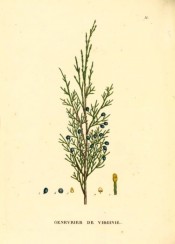Juniperus virginiana L.
Fully-hardy, evergreen conical or columnar tree with spreading branches, peeling bark, pointed, wedge-shaped juvenile leaves, diamond-shaped, scale-like adult leaves, and ovoid, brownish fruit ripening in the first year. To 30m. There are numerous garden forms. [RHSE, Hortus, Hilliers’].
Horticultural & Botanical History
Introduced to Europe in 1664. [JD]. ‘Unlike the subject of the preceding article, this species rises into a tree of considerable size. It is the largest of the Junipers growing within the original limits of the United States, though it appears that Lewis and Clarke brought home specimens of a lofty tree, with foliage resembling the Savin, found on the banks of streams among the Rocky mountains, and which is supposed to be the same with J. excelsa, growing in Siberia.
Michaux, in his North American Sylva, informs us, that it is found from Maine and from Lake Champlain, without interruption to the Cape of Florida. In the Middle and Northern states, it frequents the most barren soils, being found in abundance upon dry, rocky hills, where scarcely any other tree can subsist. Its size, however, is said to be here inferior to that which it attains in Virginia, and farther south. Its habit and foliage abundantly distinguish it from the species in the last article. From the Juniperus Sabina, or common Savin of Europe, its botanical distinction is by no means easy. The general appearance and arrangement of the leaves in the full grown specimens of both is precisely the same, except that in the Red cedar the leaves are shorter and more compactly imbricated, having an ovate form, while in the Savin they are somewhat longer and more remote, and may be called lanceolate, in the Red cedar they are also more universally pungently acute. The characters of the latter species, which I have seen given by different botanists, are almost all defective, in ascribing to it ternate leaves, which, I believe, never exist except in imperfect or distorted specimens. Its more true character is as follows. Trunk arboreous, upper leaves imbricated in four rows, ovate, pungently acute. It is by no means certain that on mature examination all the present species of Juniper will be found sufficiently distinct to be kept separate.
The Red cedar, when full grown, is a middling sized tree, though, on account of the value of its wood, it is seldom suffered to reach its full dimensions. [American Medical Botany vol.3, p.49/1820]. Saint-Hilaire Arb. pl.36/1824.
History at Camden Park
Listed in the 1845, 1850 and 1857 catalogues [C.47/1845].
Notes
Published Aug 03, 2009 - 01:03 PM | Last updated Jul 16, 2010 - 05:03 PM
| Family | Cupressaceae |
|---|---|
| Category | |
| Region of origin | Eastern USA |
| Synonyms | |
| Common Name | Pencil cedar, Red cedar |
| Name in the Camden Park Record | Juniperus Virginiana - Virginian red Cedar |
| Confidence level | high |


